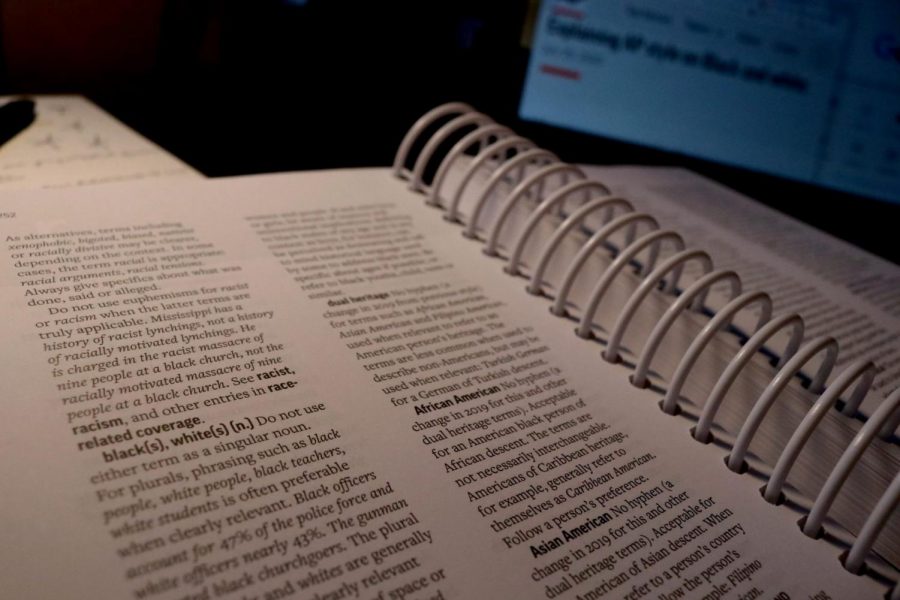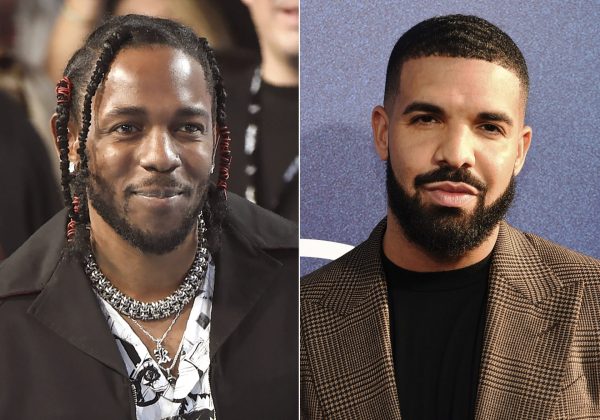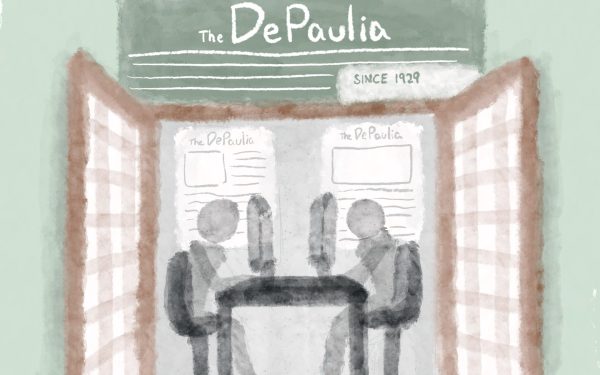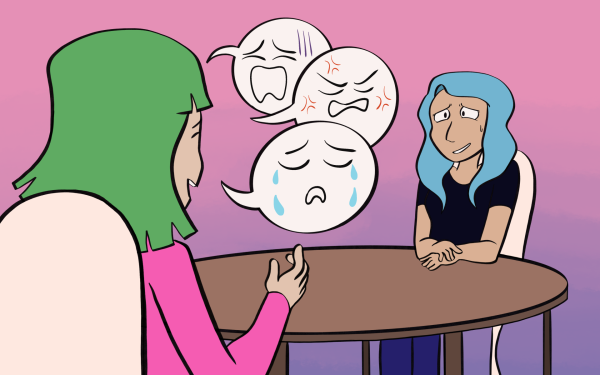OPINION: The capital “B” in Black matters
Audrey Champelli | The DePaulia
The 2020-2022 print edition of the AP Style Guide includes a section on race-related coverage, though some entries may already be outdated.
When former Minneapolis police officer Derek Chauvin forced his knee upon 46-year-old George Floyd in Minneapolis, Minnesota on May 25, 2020, my family gathered around the flat screen in the living room of our suburban townhouse to see what happened.
Wide-eyed and on edge, we sat close together, flipping from channel to channel, absorbing every detail reported by the pressed and polished news anchors.
It took less than a day for public outcry for justice to erupt at unimaginable volumes.
From news outlets that attempted to portray peaceful protests as riots to trolls on social media who tried arguing that Black Lives Matter affiliates were violent, the public discourse around Blackness was skewed by misinformation, which exacerbated the destructive ways we think, talk and write about race and racism.
On Juneteenth last year, the Associated Press (AP) — one of the most well-respected news cooperatives which creates the style guidelines that nearly all news publications abide by — changed its writing style guide to capitalize the “B” in Black “when referring to people in a racial, ethnic or cultural context,” according to its website.
The change in the AP style guide is a good first step toward racial equality and justice in the U.S., and writers across genres, personal or professional, should adopt the rule in a collective effort to recognize and respect the experiences of people of color.
When it comes to spoken language, DePaul associate professor of Spanish and linguistic program director Bradley Hoot said written and verbalized language are constantly changing between generations, but the two can intersect in the interest of both convention and social values.
For example, in the English language, the months and the days of the week are considered proper nouns and the first letter of those words are capitalized. But in Spanish, the words are all lowercase. This difference is not because one language puts more importance over the words than the other, but because it’s a matter of practice, according to Hoot.
“On the one hand, capitalization doesn’t mean anything,” Hoot said. “But on the other hand, it can be meaningful given the conventions in which it’s used.”
So when it comes to capitalizing the “B” in Black “when referring to people in a racial, ethnic or cultural context,” Hoot said he respects the change as someone who appreciates language, despite being unable to speak directly to the significance of the usage of the written language as a linguist who focuses on how we speak language rather than how we write language.
“Just because I am fundamentally interested in the scientific facts of language and not so much the usage side of things, I still think it’s important to express ourselves in a respectful way,” Hoot said. “And I think you should call people what they want to be called. It’s a general rule of politeness.”
But capitalizing the “B” in Black when referring to people of color is about more than just etiquette. Keeping the “B” in Black lowercase for so many years was a way to manipulate language to negate, undermine and erase Black identity and culture, and it’s a reflection of the historical and systemic neglect and oppression of people of color.
AP’s decision to capitalize the “B” raised the same question about the “W” in white.
According to the National Association of Black Journalists’ (NABJ) website, “Whenever a color is used to appropriately describe race then it should be capitalized, including White and Brown.”
If the organization that represents Black journalists recommends capitalizing the “W” in white, then that shouldn’t be taken lightly. We need to listen to what Black journalists and journalists of color advise, but because of the abuse of the capital “W” in white used by white supremacists to enforce racial superiority, keeping the “W” lowercase while we work toward racial equality will allow us the time to reshape how we think, talk and write about whiteness. Until the reputation of the word “white” evolves from its ties to white supremacy, it should remain lowercase.
“‘White’ should be capitalized, too,” American historian Nell Irvin Painter wrote in a StarTribune article. “White Americans have had the choice of being something vague, something unraced. No longer should white people be allowed the comfort of this racial invisibility; they should have to see themselves as raced. Being racialized makes white people squirm — so let’s racialize them with that capital W.”
Despite the NABJ’s recommendation and Irvin Painter’s argument, the “W” in white should remain lowercase until such an adoption could be more widely accepted after significant societal change occurs.
“By minimizing the “W” in white, we speak to the historical facts that Europeans have immigrated to this country who have been able to remove their national identity as German, Polish, Irish, English, Swiss to become white in America, which has given them privileges over different communities of color,” said Judith McCray, president and founder of Juneteenth Productions and faculty advisor for DePaul’s first Association of Black Journalists chapter. “To then make this a racial group, when the only reason this racial group was created was to be extended privileges, emphasizes white supremacy.”
Whiteness should not be considered racially neutral or the racial norm. White people instead need the education and the tools to discover their racial identity — if not already defined — and disclose those identities in an effort to self-racialize.
Capitalizing the “W” in white gives more power to the seemingly un-racialized group of people by allowing them the liberty to define their identity based solely on the pigmentation of their skin.
According to Amor Kohli, department chair of African and Black diaspora studies at DePaul, the capitalization of the “B” in Black and the lowercasing of the “W” in white does not mean the work toward racial justice and equality is over at this juncture.
“[There has been] a resistance to fully reckon with the legacies of historical racism,” Kohli said. “[The capitalization of the ‘B’ in Black] is meaningful action, but it is only the very surface of what we need to do. And my concern has been that surface activity is being understood as a deep reckoning. It’s taking the place of that, and it can’t be. It involves a lot of work and discomfort that people don’t like.”
But how do we work toward racial equality?
According to Kohli, anti-racism starts with listening, having open conversations about race and taking meaningful action.
“Our university is falling short on a lot of this,” Kohli said. “And I would love to see more attempts at long-term, meaningful change. You asked if this would make a difference, and I said, ‘Yeah, in time, it will,’ but I don’t know if we have all that time to wait.”
Capitalizing the “B” in Black while keeping the “W” in white lowercase when referring to people in a racial, ethnic or cultural context is a mere symbol of my solidarity with people of color. The work toward racial justice and equality is only just beginning, and we need to do more.
Confront the discomfort. Learn the history of racism and anti-racism. Dive deeply into self-education through books, documentaries, workshops, and support businesses and organizations led by people of color.
No matter your personal or professional practices, capitalize the “B” in Black and lowercase the “W” in white. It’s the least we can do as we dismantle systems of white supremacy within the news industry and beyond.
This change in the way we write about people of color is a small but powerful step that will force us to continue to have important conversations about race and racism in the U.S that have been neglected for centuries.
Don’t be a bystander. Be an ally –– even in your writing.


















Bilal • Apr 20, 2021 at 1:08 pm
I found this article to be very informative. Thank you for writing it! This was an issue that I wasn’t even aware of and believe needs addressing in more mainstream settings. We as a society need to bring forth issues such as these and have a meaningful discussion if we ever want to improve ourselves.
Zach is wrong • Apr 20, 2021 at 12:26 pm
Hi Zach: your comments just showed your bigotry, sterotyping, hate and racism. “Why are white people so afraid of equity”. Your first rhetorical question just lumped all white people together as a group and you make an unconscious biased conclusion about all people. You are giving your self a congratulations for doing the easiest possible thing and do not realize that your black “brothers and sisters” is incredibly patronizing and racist. They are not your brothers or sisters at best they are your friend or neighbors. Perhaps you need to look in the mirror and “Do better”
Zach • Apr 20, 2021 at 9:40 am
Why are white people so scared of equity? Why can’t the white person accept small steps in his or her privilege to adjust for the decades of oppression caused to Black people? Why can’t the white person acknowledge the sins of his or her past, educate him or herself, and take steps in improving society for all? Why do whites fear equity? If capitalizing the B in Black is a step we can take to show solidarity with our Black brothers and sisters, why not do it? It’s a single capital B that can mean a world of difference for the Black community and its perception through writing and media. The closing line of this piece is simple yet profoundly impactful, “Don’t be a bystander. Be an ally – even in your writing,” Change happens on a personal level. Be the positive ally instead of the impartial bystander.
I loved this piece, and I think all DePaul students must read it. Thanks!
barebones • Apr 20, 2021 at 9:09 am
“A rose by any other name ….”
Justin • Apr 19, 2021 at 9:10 pm
Today’s antiracist ideology is really ra hat communist propaganda designed to divide and confuse this country’s populace. The author of this article is a useful idiot of those interests…
Me • Apr 19, 2021 at 3:32 pm
This letter is a racist piece of tripe, explicitly endorsing a black-supremacist meme. If the DePaulia truly stood against racism, this article would have never seen the light of day.
Killer Marmot • Apr 19, 2021 at 1:55 pm
In tomorrow’s editorial: Can more black angels dance on a pinhead than white angels, and is so, is that racist or anti-racist?
StarW • Apr 19, 2021 at 6:41 am
Wow I didn’t realize this publication was in the business of delivering racist, bigoted, biased writing under the guise of allyship.
suss • Apr 14, 2021 at 12:37 am
Let’s take a step back and look at what was just said.
“Capitalizing the “W” in white gives more power to the seemingly un-racialized group of people by allowing them the liberty to define their identity based solely on the pigmentation of their skin.”
My question is, would this happen if you capitalize the B as well? Would it give such a power in the case of the capitalized “B”?
“the “W” in white should remain lowercase until such an adoption could be more widely accepted after significant societal change occurs.”
Just looking at all of this, this may come off as racist. It seems racist to me.